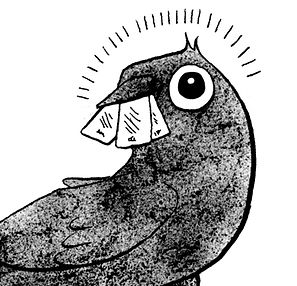Tarot by Numbers
- Brett Seivwright

- May 29
- 4 min read
Skim through a Tarot deck and you’ll notice immediately that every card is numbered. Whether it’s in the Minor or Major Arcana, each card has a tidy little number at the top. Probably a Roman numeral, because Tarot likes to be antiquated. While there is something visually appealing about these numbers, their function is more than aesthetic. The numbers are a key ingredient of interpreting Tarot.

Tarot dips its toe into numerology, a numbers-based system of divination which, as someone who brawls with arithmetic on the daily, activates my fight-or-flight response. That being said, familiarizing yourself with Tarot’s relationship to numerology will deepen your practice and allow for more fluid, nuanced interpretations of the cards.
Both the Major Arcana and Minor Arcana have numbers. As a refresher, the Major Arcana are the big-name cards that distinguish Tarot from other, similar decks of cards; the Empress, the Chariot, Death. The big guys. They detail the Hero’s Journey, the template for adventure stories everywhere. The numbers in Tarot’s Major Arcana mark the narrative order beginning with The Fool, our inexperienced adventure-seeking protagonist, and culminating with The World, indicating lessons learned, missions completed, and the willingness to embrace a new path.
In the Minor Arcana – also called the Pip cards – the numbers play a more symbolic role. The Pips are structured exactly like a playing card deck, albeit with fourteen cards per suit instead of the usual thirteen. (Shoutout to the Knight.) We’ll talk about the royals (Page, Knight, Queen, King) another time. For now, let’s focus on the Ace through Ten, because that’s where the numerology really comes into play.
Aces
Beginnings. Inciting events.
The start of each suit, and thus an indicator of beginnings. This beginning will likely come as an inciting event (a job offer, a crush, a new interest) or as a moment of inspiration or epiphany. We can also describe Aces as embodying the pure theme of their suit. I wrote a blog about the Tarot suits if you want to learn more.
Twos
Partnerships and pairings. Forces combining.
A mutual love, a business deal, a rivalry; twos indicate disparate forces interacting, and the suit denotes the nature of that interaction. Alternatively, a Two can be read as “step two.” If the Ace is an idea or a moment of inspiration, then the Two would be the planning stage where we start to conceptualize how to pursue our newfound muse.
Threes
Results. Things coming together.
Threes are manifestation. I resent using that word because it has some New Age-y connotations that make it hard for me not to roll my eyes, but it is an apt description of the Threes. Threes are the moment where the hypothetical becomes real. The ship sails, the business opens, the relationship is made official; cheers and huzzah, the thing is happening!
Fours
Security. Predictability. Business as usual.
When it comes to Fours, we’re talking stability and safety. Squares, rectangles, four legs of a table, four points of a compass; Fours are made to endure. Fours are great in that they’re secure and dependable, but potentially lackluster in their unchanging monotony.
Fives
Challenge. Difficulty. Struggle.
In Cartomancy in Folk Witchcraft by Roger J Horne (a book I’d recommend to any card reader), Horne writes “Five to throw the wheel [of the carriage].” This remains one of my favourite summaries for Fives. If Fours are stable and secure, Fives represent balance being thrown off, usually by unexpected circumstances. This is not inherently bad… but it’s likely uncomfortable, and the human brain has a hard time embracing change.
Sixes
Harmony. Forward movement.
We love Sixes; they’re sweet and gentle. They represent harmony and smooth sailing as a result of the experience acquired from the trials of Five. Some practitioners refer to the Sixes as “roads” because in a playing card deck the Sixes are illustrated in parallel rows of three, creating the impression of a road or alley.
Sevens
Fickleness. Change of luck.
Sevens are… interesting. Seven is regarded as both a lucky number and a magical one, which makes them very hard to peg down. I’ve heard them described as good and bad in equal measure. In lieu of all that, I’ve come to think of Sevens as fickleness. Strokes of good luck, strokes of bad luck. When things take a sudden turn, the Sevens are there to announce it. Look to the reading’s dominant suits and to the other cards at play to determine the nature of that turn.
Eights
Planning. Experience.
Eights are the planning card. They represent preparation for how we want things to go. In the Coins, they represent a business plan. The Eight of Cups is planning a relationship; a proposal, if you will. Furthermore, the Eights indicate that we’re not going in blind, but conceptualizing based on experience. We have enough savvy to plot smartly and execute our plans effectively.
Nines
Culmination. Epitome.
There’s a folk-Christian belief (I forget where from) that Nine is the holiest of numbers; three times three, representing a trinity for each of God’s aspects. Narratively, Nines are the climax. They represent the culmination of our experiences and the payoff that comes of them – be they for better or worse.
Tens
Completion. Endings. Moving on.
Last card, the end! If Nines are the climax, think of the Tens as the denouement. A journey is over, and we’re sitting with what has come of it. Whether it’s a happy ending or a sad one, Tens indicate that a story has come to its end and it’s time to move on to other things.





Comments